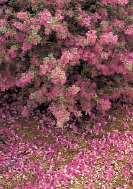
![]() chapter THREE
chapter THREE ![]()
Success with Desert Plants
When considering vines, be aware of the different methods in which they climb. Some do not climb at all, and must be tied in place. Others are self-climbing, with tendrils, twining stems, grasping rootlets or a combination of methods. If you have stucco walls, avoid plants that climb with rootlets. They may cause serious damage.
Antigonon leptopus
queen’s wreath, coral vine

In its native habitat, this Sonoran Desert native is usually found growing in canyons. It is a rapid-growing, twining climber, the stems up to 40 feet long providing quick, attractive cover. Leaves are bright green, large and heart-shaped. Queen’s wreath blooms profusely with large clusters of bright pink flowers with deeper pink centers. Flowers attract bees. Plant goes dormant and freezes to ground when temperatures drop below 32°F. It regrows from roots when warm temperatures return in spring. If low temperatures are expected, cover roots with a deep layer of mulch.
‘Baja Red’ produces bright red flowers.
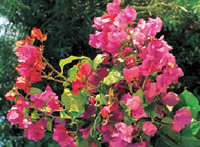
Bougainvillea species, bougainvillea.
Bougainvillea species
bougainvillea

Bougainvillea species are popular “workhorse” plants in the Coachella Valley. Shrub and vining forms produce volumes of color from their bracts—the modified leaves that surround the actual, tiny white flowers. Select a warm microclimate for a planting site because bougainvillea is relatively frost-tender. If nipped by frost, wait until spring to remove frost damage. Plants produce a lot of litter, so avoid planting near pools. After young plants are established, keep bougainvillea on the dry side, which surprisingly encourages plants to produce more flowers. Originally native to South America. Numerous cultivars are available in a wide range of colors. A few favorites are listed here.
‘Barbara Karst’ produces cascading masses of large, brilliant red to magenta bracts that are borne almost continually. One of the earliest to bloom each year. Can take lower temperatures than the other cultivars. ‘California Gold’ has rich golden orange bracts that bloom profusely in vivid contrast to its deep green leaves. ‘Jamaica White’ has masses of frothy, sea foam white bracts that cascade from branch tips. Blooms occasionally take on a slight pink tinge with cooler weather. ‘Orange King’ is covered with bronzy orange-gold flower bracts in graceful sprays. ‘Texas Dawn’ produces rosy pink bracts suspended from long arching sprays. ‘Temple Fire’ is a newer cultivar that is partially cold-deciduous with bronze-red bracts.
These two are more shrublike in their growth habit: ‘Crimson Jewel’ has luxurious, dark foliage, which make an ideal background for hundreds of brilliant, glowing, red bracts. Plant grows vigorously from 3 to 5 feet high. ‘La Jolla’, with red bracts, is similar but more compact. It is good in containers.
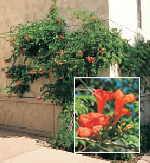
Campsis radicans, trumpet vine.
Campsis radicans
trumpet vine

This southeastern United States native is tolerant of the harsh summer growing conditions in the Coachella Valley. It is vigorous and self-climbing to 20 feet or more high and wide. The dark green leaves are deciduous in winter. Clusters of 3-inch, orange or red flowers bloom summer and fall and are pollinated by hummingbirds. Rapid growth rate. Use as a color accent, shade or screening. Grows best in partial shade. Provide regular water to maintain flowers and dense foliage.
Clytostoma callistegioides
lavender trumpet vine

(Bignonia violacea, B. speciosa). This evergreen vine accepts sun or shade. Pale lavender to violet, trumpet-shaped flowers 3 inches long bloom in spring and summer, set off by glossy green leaves. It climbs by tendrils, then terminal shoots cascade downward for a curtainlike effect. Prune in late winter to control and to renew plants. Native to Brazil.
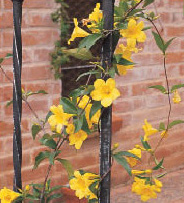
Gelsemium sempervirens, Carolina jessamine.
Gelsemium sempervirens
carolina jessamine


An evergreen, twining vine with rich green leaves. Climbs to about 20 feet, but does require support. Profusion of trumpet-shaped, bright yellow, fragrant flowers bloom in late winter to early spring. Does best in partial shade in the Coachella Valley. Cut back severely if it becomes too heavy. Note that all plant parts are poisonous. Native to southeastern U.S.
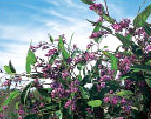
Hardenbergia violacea, lilac vine.
Hardenbergia violacea
lilac vine

An evergreen vine with long, rich green leaves. Bark is a rich cinnamon brown. Climbs by twining to 10 feet in just one year, but requires support. Dense clusters of sweet pealike, bright lilac-purple flowers bloom in late winter to early spring. Wonderful evergreen cover on arbors, especially as it ages and the richly colored bark gets to show off. Accepts some shade. Cultivars are available in shades of white, pink and blue. Native to Australia.
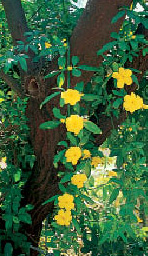
Jasminum mesnyi, primrose
jasmine.
Jasminum mesnyi
primrose jasmine

(Jasminum primulinum). Fast growing, reaching to 10 feet in the first year, with medium green leaves and large yellow flowers bloom in late winter. A sprawling vine, it can be tied onto trellises. Controls erosion on banks, cascading down them. Left alone, it develops into a large, fountain-shaped shrub. Accepts some shade. Native to western China.
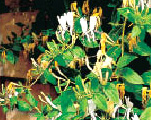
Lonicera japonica 'Halliana', Hall's honeysuckle.
Lonicera japonica ‘Halliana’
hall’s honeysuckle

Vigorous, twining, evergreen vine that is occasionally grown as a rampant ground cover. Fast cover on fences and trellises. Renew growth by cutting plants back severely in late winter every year or two. Highly fragrant flowers are pure white then quickly turn golden yellow. They are most profuse in spring, blooming sporadically in summer. Medium green foliage. Accepts full sun to partial shade.
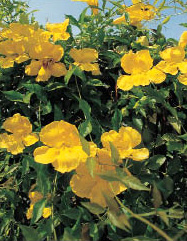
Macfadyena unguis-cati, catclaw.
Macfadyena unguis-cati
catclaw

Dense green foliage shows off bright yellow flowers that cover the plant in spring, although flowering is profuse, the season is short lived. Rapid, vigorous growth with clinging rootlets, it can spread 30 to 40 feet vertically or horizontally. Best on chain link fence or brick—it has been known to pull stucco off walls. Native to Central and South America.
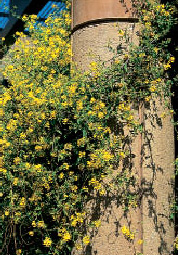
Mascagnia macroptera, yellow orchid vine.
Mascagnia macroptera
yellow orchid vine

(Callaeum macropterum). Twining vine with small, interesting, medium green leaves. Use on a trellis, chain-link fence or any upright support. Accepts some shade. Dense clusters of showy, yellow, orchid-shaped flowers appear in spring (if plants did not freeze the previous winter), and in fall. Remove frost-damaged leaves and stems in late winter or early spring. Moderately fast grower, reaching 15 feet in a year. Native to Mexico.
A similar plant is Mascagnia lilacina, purple orchid vine. It is about the same size and habit as yellow orchid vine, but is more cold hardy and flowers are purple.
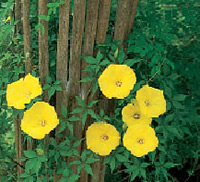
Merremia aurea, merremia.
Merremia aurea
merremia

This vine can grow to 25 feet or more with support. Bright yellow, 2-inch, morning glory-type flowers bloom summer and fall, accompanied by dense, bright green leaves divided into five leaflets. Requires full sun for good growth and flowers. Regular water during growing season is necessary for flower production. Plant near a wall, fence or other structure on which to climb. Fast growth allows its use as wind or sun screen. Control rampant growth with pruning. Remove frost-killed vegetation in spring after danger of frost has passed—plants recover quickly. Native of southern half of Baja California.
Also consider Merremia dissecta, mile-a-minute vine, with white flowers.
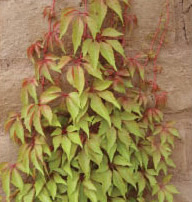
Parthenocissus tricuspidata 'Hacienda Creeper'.
Parthenocissus tricuspidata ‘Hacienda Creeper’

hacienda creeper
This cultivar of Boston ivy is semievergreen. A vigorous, clinging vine that will attach itself to masonry walls and stonework. Bright green, compound leaves turn to vivid shades of red and orange in fall. Locate where plants will receive some shade, preferably in the afternoon. Hybrid of parents native to China.
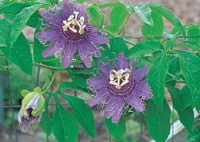
Passiflora X alatocaerulea, passion flower vine.
Passiflora X alatocaerulea
passion flower vine

(Passiflora pfordtii). Twining evergreen vine rapidly growing to 30 feet in a single year. Foliage has a tropical look with three parted, bright green leaves. Masses of 4-inch, spectacular flowers bloom in summer and are used to make perfume. Flowers are pink tinged white, with a crown of purple. Accepts some shade. Protect from wind. Hybrid of P. alata of Peru and P. caerulea of Brazil.
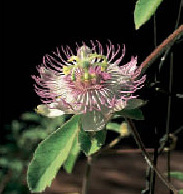
Passiflora foetida longipedunculata, baja passion vine.
Passiflora foetida longipedunculata
baja passion vine

This evergreen twining vine can grow to 10 feet in a year. The gray-green leaves are velvety and provide a nice backdrop to the white with lavender blooms that last through the warm season. It can freeze to the ground, but will rapidly recover in spring. Accepts some shade. Native to Baja California.
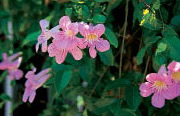
Podranea ricasoliana, pink trumpet vine.
Podranea ricasoliana
pink trumpet vine

Twining vine with stems up to 20 feet long. Rich green leaves are divided into 9 to 11 leaflets. Clusters of pink flowers to 2 inches long bloom summer and fall. Stems damaged by frost recover rapidly in spring. Use on a trellis or chainlink fence, tying stems in place. Ideal plant for high-water, mini-oasis garden location. Native to southern Africa.
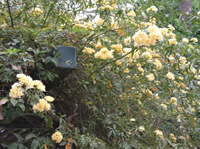
Rosa banksiae, Lady Banks' rose.
Rosa banksiae
lady banks’ rose, tombstone rose

Provide this popular evergreen to semideciduous vine with sturdy supports as it grows vigorously to 10 to 25 feet. Lady Banks’ rose is suited to large-scale landscapes, where it can spread out or climb an arbor. This rose produces no thorns, so it is fine to use near pedestrian traffic areas or by pools. Native to China.
‘Lutea’ blankets plants with double pale yellow flowers in spring. ‘Alba Plena’ has double white flowers. Native to China.
Trachelospermum jasminoides
star jasmine


(Rhynchospermum jasminoides). Lustrous, deep green, leathery foliage, this plant is most admired for its masses of white, highly perfumed, star-shaped flowers, which bloom most heavily in spring. Versatile uses include espalier, pillar support vine or ground cover. Needs support such as a trellis on which to climb. Best on east or north exposures. Native to China.
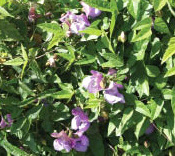
Vigna caracalla, snail vine.
Vigna caracalla
snail vine

(Phaseolus caracalla). Snail vine is a vigorous, twining plant, reaching 30 feet in a year. With a foliage effect similar to the vegetable pole bean, it makes an excellent screen. Masses of slightly fragrant, showy, lavender flowers bloom throughout the year. Excellent trained on wire fences or on banks. Remains evergreen in mild winters. If frost kills top growth, cut back in early spring to rejuvenate growth. Occasionally mislabeled as Phaseolus gigantea. Native to tropical South America.
Vitis californica
california wild grape

Climbing by tendrils, wild grape can reach 30 feet in a summer. Grow it for the foliage, not the tiny, tart fruit. Leaves emerge gray and brighten to green, then turn red in fall and drop. Vines regrow the following spring. ‘Rogers Red’ holds its gray-green leaf color all summer, then turns brilliant red and orange in fall. Native to California and Oregon.
Vitis vinifera
grape

This deciduous vine is grown for its fruit, as well as for the lush, heart-shaped medium green leaves. It clings by tendrils, growing vigorously to 10 to 20 feet, supplying cooling summer shade. Provide vines with a sturdy support structure. Prune canes in winter. Grape leaf skeletonizers arrive in waves during summer to quickly strip leaves. Watch for the small, blue-black, slow-moving moths that lay the eggs. Native to the Mediterranean.
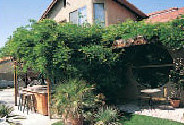
Wisteria floribunda, Japanese wisteria.
Wisteria floribunda
japanese wisteria

The bright green foliage of Japanese wisteria is deciduous. Twining, woody growth reaches to 25 feet. Native to Japan. ‘Longissima Alba’ is impressive with its pure white flowers that cascade in spikes to 4 feet long. ‘Royal Purple’ attracts attention with long, violet-purple flowers in spring. Often sold as W. multijuga.
Wisteria sinensis
chinese wisteria


This is the more commonly grown wisteria in the West. It has a twining and deciduous form with medium green foliage. Needs support to grow; such as on top of an arbor. It reaches up to 30 feet long. In spring, puts on a show of purple or white flowers, depending on cultivar. Native to China.